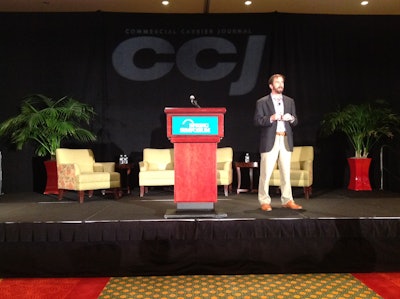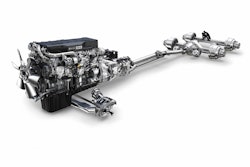 Dave Ross on May 21 speaking at the CCJ Spring Symposium in Franklin, Tenn.
Dave Ross on May 21 speaking at the CCJ Spring Symposium in Franklin, Tenn.“A slow squeeze” is how transportation analyst Dave Ross describes what has been taking place in the transportation industry of late. But, should his predictions prove accurate, the squeeze will lead to a very favorable rate environment for carriers. Rate increases of more than 10 percent could be possible, he said.
“Over the next three years there is going to be a situation where there is not enough trucks to haul freight,” said Ross, the managing director of transportation and logistics for stock analyst firm Stifel, Nicolaus and Company. Ross spoke at the CCJ Spring Symposium on May 21 in Franklin, Tenn.
“Shippers had it good for a very long time. That is about to change.”
The driver shortage has been a constant for 20 years or more. Truck drivers are not getting any younger and the amount of pay increase it would take to change that is not likely to happen. Furthermore, new regulations, higher equipment costs and other factors continue to squeeze capacity growth.
The supply chain will continue to become more efficient, he said, but overall economic growth will put the wind in the sails of carriers yet forward progress could be slow. The recovery is moving at a slower pace than any recovery period in the past 80 years. Ross predicted an average rate of 0.75 percent GDP from 2014 to 2050, with a caveat that the next recession could be around the corner.
Following the recession that started in 2008, the economy is now 58 months into a recovery. This period matches the average for every recovery period since World War II.
Some of the troubling economic signals are the slow growth of personal income. Real median income is about $52,000 which “is not close to where it was during the peak in 2008,” he said. “Nobody is getting big raises.” People and corporations are still very much focused on savings which is limiting demand and growth.
“We are not back to even yet,” he added. Manufacturing has been strong since last summer but underlying consumer demand is “muted,” he said. “I am unsure how manufacturing growth can sustain expansion.”
Housing starts are still at historic lows but higher than in 2010. Auto production has been strong over last few years but how long it will continue is uncertain.
Ross said that rail intermodal will see the strongest growth of all transportation sectors. Year to date, intermodal volumes are up by 5.1 percent and by 10.7 percent in the last four weeks.
“I think intermodal will continue to be a growth area above market rates for the next 10 years,” he said.
The list of factors that could increase capacity include immigration reform, long combination vehicles like 32-foot twin trailers for less-than-truckload networks and Mexican trucks. The list of factors that could reduce capacity is much longer, however. It includes the Compliance, Safety, Accountabilty program, electronic logging devices, drug testing, changes to independent contractor status, equipment costs and an increase in insurance standards.
The mandate of electronic logs, with enforcement likely to begin in 2017, is “going to be a big deal for industry capacity,” he said. “It will be flushing out a lot of smaller guys that have been hanging on for some time.”
In summary, Ross said that pricing will remain in favor of carriers due to supply constraints in a low-growth environment. He expects carriers will see profit margins grow up to four percent during the next five years, but the potential could be much higher—especially for less-than-truckload carriers.
“It is more likely that LTL freight will grow faster than we expect,” he said.













